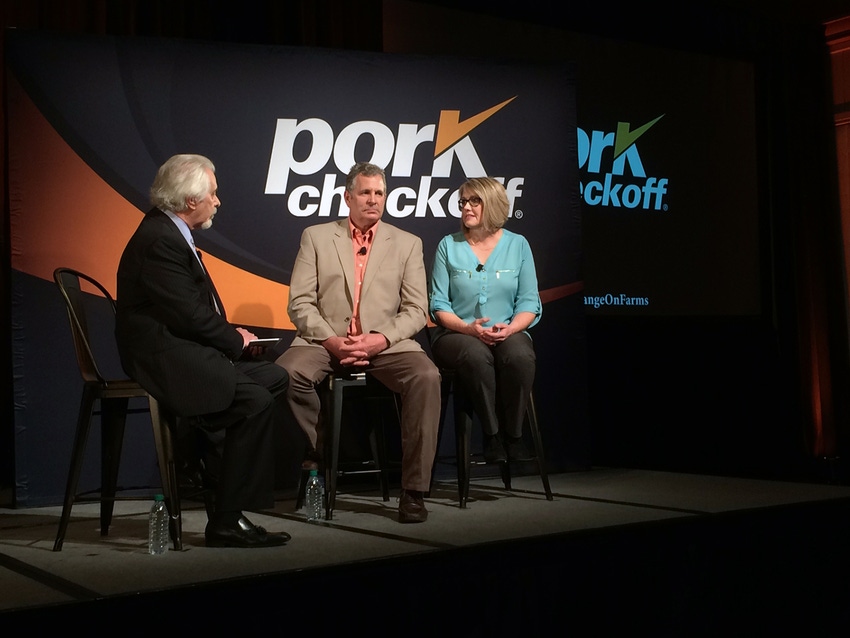Live broadcast from National Pork Industry Forum convenes industry experts to discuss real change taking place on hog farms across the country.
March 1, 2017

Source: National Pork Board
In 2016, the U.S. pork industry saw record-breaking pork production and strong ongoing consumer demand. Additionally, consumer interest in how food is produced is also at an all-time high, leading the National Pork Board today to reaffirm its commitment to antibiotic stewardship during a live online broadcast event. Real Change: A Live Discussion of On-Farm Antibiotic Use, hosted by The Supermarket Guru Phil Lempert, brought together experts in pork production, retail and animal care and welfare for a live, web-based broadcast. During the 30-minute program, experts discussed the pork industry’s leadership in responsible antibiotic use and how it has implemented new strict guidelines set by the U.S. Food and Drug Administration. Those guidelines went into effect Jan. 1.
“There is very real change happening on the farm, and we want those who care about these issues to understand the commitment that pig farmers have with regard to antibiotic stewardship and continuous improvement in animal welfare,” says John Johnson, chief operating officer of the NPB. “For nearly two years, we have been educating farmers on antibiotic stewardship, investing in research and helping prepare for these changes. Hands down, it has been our largest pig farmer education campaign ever.”
FDA guidance 209 and 213 ends the use of medically important antibiotics for growth promotion and increases veterinarian oversight for on-farm antibiotic use through the Veterinary Feed Directive and prescriptions. All human medically important antibiotics administered to pigs in feed and water must have direct veterinarian oversight. This creates a strong veterinary-client-patient relationship between pig farmers and their veterinarians. These same pig farmers and veterinarians also are taking pig management and biosecurity steps that increase the health of pigs and reduce the need for antibiotics.
“We’ve always been committed to a process of continuous improvement in a number of areas, especially regarding responsible antibiotic use,” says Brad Greenway, a pig farmer from South Dakota and America’s Pig Farmer of the Year. “We have a great relationship with our veterinarian, with regular check-ins to make sure we’re operating safely and effectively. It’s only when it is medically necessary for the well-being of the animal that we are prescribed antibiotics. … the relationship that we have with our veterinarian is vital; assuring the consumer that pork is a safe product.”
Michelle Sprague, veterinarian and director of sow health at AMVC Management Services, says veterinarians and pork producers can make great strides in reducing antibiotic use by monitoring herd health issues. “If we can get in front of the disease pressure in a herd, we can actually reduce antibiotic use,” she says.
Another important topic addressed during the broadcast relates to antibiotic resistance — a complex issue that affects both veterinary and human medicine. The U.S. Centers for Disease Control and Prevention estimates that 47 million human prescriptions are not medically necessary, at least 30% of all prescriptions written.
“The CDC has warned us that antibiotic resistance is one of the world’s most pressing health problems, and that’s why we’re committed to doing our part in antibiotic stewardship,” Johnson says.
“In the end, we’re committed to defining the ideal balance of the right medicine, in the right dose, at the right time for our pigs,” Sprague says.
Shifting to the consumer landscape, the broadcast also focused on consumer concerns about food safety and animal welfare. The use of antibiotics on the farm has drawn increased questions from consumers, and the pork industry is dedicated to encouraging an open dialogue, working with its partners and building confidence in today’s pork supply.
“It’s a shared responsibility, and we all have to do our part to navigate this evolving discussion about antibiotics and providing safe food to our consumers,” says Rick Stein, vice president of fresh foods at Food Marketing Institute. “Organizations like the National Pork Board are getting out there and being stewards of this complicated and evolving issue. The pork industry invites collaboration and constructive criticism among the leaders in food production and distribution.”
Stein says consumers are “thirsty for transparency” in the food chain. “We need to gain and keep the trust of the consumer,” he says. “At the end of the day it’s about providing a safe product. How much does the consumer know about the antibiotic issue? They do know that antibiotic overuse is not good, so we need to do a good job of telling our story about antibiotic use.”
A replay of the broadcast can be viewed online. For more information on the National Pork Board’s efforts to assist farmers and others who want to learn more about responsible on-farm antibiotic use.
National Hog Farmer's Kevin Schulz also contributed to this article.
You May Also Like


